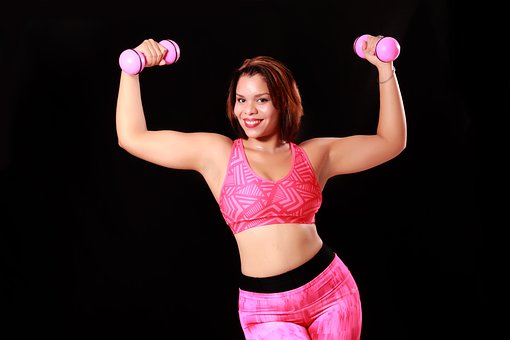Show me your muscles!
If you’re a woman of a certain age, flexing your muscles for show probably isn’t something you do on the regular.
That’s not “ageist”. It’s honest.
There’s an entire segment of women in the breast cancer population who didn’t grow up hitting the weight room to build strength and manage stress.
Even if you now belong to a gym (COVID considered), weight training still may not be part of your routine.
Lifting weights can feel intimidating.
You don’t know:
- the right amount of weight to use
- which exercises work which muscles
- what’s safe or what’s crazy
So you skip the weight work/strength training completely. Stick with what’s familiar, like the treadmill.
And yet, you know you’re at increased risk of low bone density and/or osteoporosis (thanks, cancer), so you want to do something about it.
It’s likely you’ve heard exercise can help build strong bones, and weight bearing exercise is key.
May is National Osteoporosis Month. Previously I wrote about foods to eat for bone health, and in this post I address the role of exercise.

How To Know Whether Your Bones Are at Risk
Bone densitometry, also called DEXA or DXA is used to measure bone loss in your lumbar spine and hips.
DEXA test results don’t predict whether you’ll experience a fracture, but show relative risk and help determine if treatment for bone loss is required. (1)
Your test results will be in the form of two scores: T-score and Z-score.
- T-scores indicate how much bone you have compared with a young adult of the same gender and peak bone mass.
- Z-scores indicate how much bone you have compared with other people in your age group and the same size and gender.
Regardless of your DEXA score. . . [easy-tweet tweet=”The goal is to preserve as much bone mass as possible.” user=”dammadbrstcancr” hashtags=”#breastcancer, #nationalosteoporosismonth”] Unfortunately, breast cancer treatment and medications like aromatase inhibitors can make that challenging.

How Exercise Helps
It doesn’t matter what you’ve heard, no amount of exercise can stop the biological process of aging. This includes weakening bones.
The good news is, we have evidence that consistent exercise can reduce the physiological effects and increase active life expectancy by potentially limiting the development and progression of chronic disease and disabling conditions. (2)
For many women, even without a breast cancer diagnosis, developing weak and brittle bones is a common concern and an example of a potentially disabling condition.
So, just how much and what types of exercise may help improve the results from a disheartening DEXA report?
You need more than just exercise to turn things around, but let’s look at how it DOES help.
Weight bearing exercise (activity) and resistance exercise (strength training) are two different things.
Weight bearing exercise is activity you do on your feet, working your bones and muscles against gravity. Examples are walking, hiking, jumping rope, jogging, climbing stairs, playing tennis, dancing.
Strength training exercises are where resistance is added to movement to make your muscles work harder and grow stronger over time. Examples are using free weights, exercise machines, and your own body weight (i.e. doing pushups.)
Bone is living tissue, changing in response to the forces placed on it. [easy-tweet tweet=”Weight bearing exercise and strength training both place force on your bones.” user=”dammadbrstcancr” hashtags=”#breastcancer, #nationalosteoporosismonth”]
While young adults continue to build bone, as we age, our goal is to maintain the bone strength we have. (3)

What the Research Says
While general guidelines for maintaining bone strength are important, we in the breast cancer world are a unique bunch.
My question is, “Can standard exercise and osteoporosis guidelines produce the same positive outcome potential for us, given that we’re working against strong medications/treatment?”
Here are results from a couple of scientific studies I found.
- A small 2016 study (26 participants) showed significant improvement in bone mineral density at the spine, hip and whole body following 26 weeks of combined aerobic and resistance-training exercise.
For 1 hour per day, 3 days per week, for 26 weeks, participants engaged in 20 minutes of cardiorespiratory training, 25 minutes of circuit-style resistance training, and 15 minutes of exercises for core with dynamic and static stretching.
Cardio included walking, and in inclement weather, elliptical and stationary bicycle. Resistance training included the use of dumbbells, body weight and elastic bands in a 10-station circuit training program. Of note was the use of a whole body vibration platform as two stations in the circuit.
Limitations of this study were the lack of a non-exercising comparison group, not confining study to only breast cancer (there were breast cancer survivors in the group), and the small study size. (4)
- In contrast, a second study indicated that in older (≥ 50 years of age at diagnosis), post-menopausal, post-adjuvant treatment breast cancer survivors, the response to loading exercises at the hip were negatively impacted by age. (5)
What Should YOU Do?
While the two studies I highlighted appear to be somewhat conflicting, most of the research (there’s not a lot, but more than I could share here) indicates some positive benefit from load-bearing exercise.
Remember, exercise for BREAST HEALTH supports your overall BEST health.
Even if strength training and weight bearing exercise doesn’t significantly improve your bone density, it may maintain what you already have.
You’ll also:
- build muscle, making you stronger and more resilient overall
- improve your balance and stamina
- help reduce the risk of heart disease, diabetes and other diseases of aging
- potentially help maintain a healthy body weight
There’s no downside to adopting a consistent weight training routine.
Who knows? The next time someone says “Show me your muscles!”
You just might.
Now tell me in the comments below – do YOU strength train on a regular basis?
____________________________________________________________
Thanks for reading my blog post!
Most survivors of hormone-positive breast cancer get anxious when they think about what to eat after finishing treatment, so I’ve created the Peaceful Plate program to help survivors eat with peace, not panic.
When you eat with peace, you feel free to enjoy your food again.
Ready to eat with peace?
CLICK HERE and grab your FREE copy of The Five Foods Survivors Should Eat
CLICK THIS LINK and watch my 2-minute Peaceful Plate program video!
Follow me on Instagram @hormone.breastcancer.dietitian
This information is for educational purposes only and is not intended as medical advice. Please consult your dietitian or doctor for guidance specific to your needs.
SOURCES
- Bone Densitometry (DEXA, DXA)
- American College of Sports Medicine Exercise and Physical Activity for Older Adults
- Exercise and Bone Health
- Combined aerobic and resistance training improves bone health of female cancer survivors
- Exercise effects on hip bone mineral density in older, post-menopausal breast cancer survivors are age dependent.


